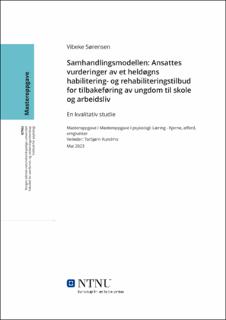| dc.description.abstract | Sammendrag
Ungdom som faller ut av skole og arbeid er et økende problem i Norge. Stadig flere ungdommer i alderen 25-29 år blir uføre. NAV og det offentlige har mange tiltak for å hjelpe unge voksne med å komme ut i utdanning eller arbeid. Der er også mange forebyggende tiltak for å forhindre frafall i skole. Likevel er det en gruppe ungdommer som dette ikke fungerer for. Formålet med denne studien er å se på hvordan de ansatte ved Ribo og Vev-Al-Plast forstår samhandlingsmodellen, hvordan de vurderer effekten av den og hvilke elementer de mener bidrar til denne effekten. Videre så blir dette tilbudet diskutert opp mot et individuelt tilpasset tiltak fra NAV. Programtilbudet ved Ribo og Vev-Al-Plast består av et attførings- og habiliteringstilbud for å hjelpe allerede marginalisert ungdom til å bli mer psykisk og sosialt i stand til å møte samfunnet på en hensiktsmessig måte. Målet er også å få flest mulig ut i arbeidslivet eller videregående opplæring Studien har gått ut på å intervjue 10 ansatte fra henholdsvis Ribo og Vev-Al-Plast. Kontekstuell innholdsanalyse ble benyttet til å analysere datamaterialet. Resultatene av undersøkelsen viser at informantene legger stor vekt på de ansattes kompetanse, og det er den uformelle kompetansen som de legger mest vekt på. De opplever at det er det helhetlige tilbudet og den samhandlingen som foregår mellom Ribo og Vev-Al-Plast som er årsaken til programsuksess. Dette fordi deltakerne i programmet får et helhetlig samordnet tilbud på tvers av sektorer. Et viktig element i dette er programtilbudets holistiske grunnsyn, der det blir lagt vekt på at alle aspekter ved livet har gjensidig påvirkning på det som skjer. Dette gjelder de psykiske, de fysiske, de sosiale og de åndelige dimensjonene, og at de gjennom samhandlingsmodellen får mulighet til å følge opp deltakerne hele døgnet og i alle aspekter ved livet deres. Videre så opplever informantene at de fleste av deltakerne finner seg til rette i tilbudet, og at en stor andel (opp mot 50%) kommer seg ut i jobb eller studier etter endt programdeltagelse. En utfordring med samhandlingsmodellen som blir trukket frem av informantene var manglende informasjonsflyt mellom Ribo og Vev-Al-Plast på grunn av personvern og regelverk rundt journalføring. Resultatene viser at programtilbudet ikke er diagnosefokusert, men løsnings- og mestringsorientert. Samtaleprogrammet som benyttes av de ansatte på Ribo er det viktigste verktøyet i behandlingen/habiliteringen. Her viste resultatene at det var varierende kvalitet på gjennomføring av metodene som brukes i programmet. Det var også varierende grad av kompetanse knyttet til teoretisk forståelse av psykologiske faktorer som er av betydning for behandlingen.
| |
| dc.description.abstract | Abstract
Young adults dropping out of school and work is a growing problem in Norway, as an increasing number of people in the 25-29 age group, are becoming disabled. NAV and the public sector have many offers to assist young adults obtain education or work. There are also many measures to prevent them from dropping out of school. Nevertheless, there is a group of young people for whom these efforts do not work. The purpose of this study is to look at how employees at Ribo and Vev-Al-Plast understand the interaction model, how they assess its results, and which elements they believe contribute to this effect. Furthermore, this offer is discussed against an individually adapted measure from NAV. The program offered at Ribo and Vev-Al-Plast consists of a rehabilitation and habilitation offer to assist already marginalized young people to become more psychologically and socially able to face society in an appropriate way. The study consisted of interviewing 10 employees from Ribo and Vev-Al-Plast respectively. Contextual content analysis was used to analyze the data.
The results of the survey show that the informants attach great importance to the employees' competence, and it is informal competence that they attach the most importance to. Participants in the program receive a coordinated offer across sectors, and the informants believe that it is this coordination and the interaction that takes place between Ribo and Vev-Al Plast that is the cause of the program’s success. An important element is the program's holistic approach, where emphasis is placed on all aspects of life having mutual influence on what happens in life. This applies to the psychological, physical, social and spiritual dimensions. Through the interaction model they get the opportunity to follow the participants around the clock and in all aspects of their lives. Furthermore, the informants believe that most of the participants are comfortable with the program, and a large proportion (up to 50%) are able to obtain work or studies after program participation. A challenge with the interaction model, highlighted by the informants, was the lack of information flow between Ribo and Vev-Al-Plast due to privacy and regulations around record keeping. The results show that the program offering is not diagnosis-focused, but solution- and mastery-oriented. The conversation program used by the employees at Ribo is their most important tool in the treatment/habilitation. Here, the results showed that there was varying quality in the implementation of the methods used in the program. There was also a varying degree of competence related to theoretical understanding of psychological factors that are important for the treatment.
| |
